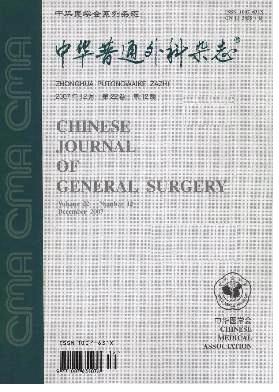Radiofrequency ablation for liver cancer in difficult place under percutaneous local anesthesia combined with contrast enhanced ultrasonography
引用次数: 0
Abstract
Objective To explore the feasibility and safety of radiofrequency ablation for difficult access liver cancer under percutaneous local anesthesia combined with contrast-enhanced ultrasonography. Methods 45 patients(62 lesions) in the experimental group were treated by percutaneous, local anesthesia combined with contrast-enhanced ultrasound and in some cases with artificial ascites assisted by radiofrequency ablation vs control group of 40 patients (54 lesions) receiving radiofrequency ablation guided by CT or ultrasound through laparoscopy or open surgery. The complications, and postoperative residual and recurrence rates were compared between the two groups. Results Of the all patients, 4 cases suffered from severe complications. The pain scores and the blood loss were less significant in the experimental group. There was no significant difference in tumor residual rate between the two groups when evaluated on one month after the procedures, and in the recurrence rate after three and six months. Conclusion Radiofrequency ablation for difficult liver cancer by percutaneous local anesthesia combined with contrast-enhanced ultrasonography is less traumatic and less of complications compared to traditional method with a similar tumor residual rate and recurrence rate. Key words: Carcinoma, hepatocellular; Catheter ablation经皮局麻联合超声造影射频消融治疗癌症疑难部位
目的探讨经皮局麻联合超声造影射频消融治疗难治性癌症的可行性和安全性。方法实验组45例(62个病灶)采用经皮局部麻醉联合超声造影治疗,部分患者采用射频消融辅助人工腹水,对照组40例(54个病灶)在CT或超声引导下经腹腔镜或开放手术进行射频消融。比较两组的并发症、术后残留率和复发率。结果所有患者中,4例出现严重并发症。实验组的疼痛评分和失血量较低。在手术后一个月评估时,两组之间的肿瘤残留率以及三个月和六个月后的复发率没有显著差异。结论经皮局麻联合超声造影射频消融治疗难治性癌症,与肿瘤残留率和复发率相似的传统方法相比,创伤小,并发症少。关键词:肝癌;导管消融
本文章由计算机程序翻译,如有差异,请以英文原文为准。
求助全文
约1分钟内获得全文
求助全文

 求助内容:
求助内容: 应助结果提醒方式:
应助结果提醒方式:


